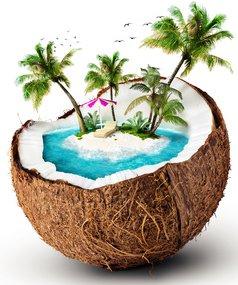 Dispatch: Coconuts and Campbell’s:
Dispatch: Coconuts and Campbell’s:
John M. Edwards traces the origins of the wackily hybrid South Pacific cargo cult of “John Fromm” (or “John Frum”) from the world’s most useful conversation starter. . . .
“Where are you from?”
“United States.”
“What is your name?”
“John.”
“Hey, I am John, too!”
Although the polite fisherman was dressed like a native, in imported out-of-date garb straight out of “That Seventies Show,” I couldn’t believe that he was neither an AWOL backpacker nor an unemployed Import-Export artist.
For real, he was a local.
“When my mother gave birth to me,” she was divorced from her husband,” John related sadly. “She denied that I was a bastard, but the other villagers threw stones at her.” Thus, they were forced out of Vanuatu–“and now we live here,” he added for effect.
“That’s a very sad story,” I replied with mental alertness, hoping for the sake of a formulating magazine pitch that he would say more.
“When I asked who my real father was, she just said ‘John Frum.’”
I had read a brief section on Oceanic cargo cults in my classic used Moon South Pacific Handbook, still pretty much the bible of time travel in Polynesia and Melanesia, but I never expected to actually meet one of its members, albeit one of obvious European descent!
Aitutaki, Cook Islands, was a long way away from Tanna in Vanuatu, where the cult formed after an American serviceman dressed in Navy whites named “John” came during World War II, bearing gifts, mostly canned goods and processed meals.
Including “Spam” (™)!
As the legend goes, when everyone asked “Where is John From?” the fledgling cult supplied a suitably outlandish surname: Frum.
They all are still awaiting John Frum’s second coming armed with profits and plenty.
Thus, one of the world’s most used conversation starters might have also been the origination of one of the world’s strangest wacko religions: “The John Frum Cargo Cult.”
One of the main beliefs of all cargo cults is that if the proper ceremonies were held, uncounted riches would be lavishly sent from some heavenly place. John Frum represented the spirits of their dead ancestors, and the “European” colonialists who had usurped their wealth, but were still willing to return it. The cargo cult members built modest replicas of airports and planes out of twigs to try to activate shipments of cargo out of thin air.
John Frum devotees are more patriotic “Americans” than your average joe in Guam, an actual American protectorate, even if most of the islands upon which they live are independent nations tied to the French or Australians, many of them with tattoos on their chests and backs saying “USA”!
Even today, in parts widely stretching from New Guinea to Vanuatu, such products as “John Fromm Soap” can be found, as well as vintage cans of “Campbell’s Soup” and antique bottles of “Coca-Cola.”
And wherever John Frum cultists are, especially in the former “New Hebrides,” there are pro-American barefoot GI reinactors with bamboo rifles and Bald Eagle tattoos raising the “Old Glory.”
James Michener’s book Tales of the South Pacific, upon which the famous Rogers and Hammerstein musical is based, is still one of the most popular reads among locals. Probably because not much has changed since World War II. Even so, anthropologists believe the cult today is based upon a much older belief system involving European colonialists who did not work hard like the locals but instead wrote down lists on paper, before magical Christmas Day-like supplies and largesse was landed for everyone.
As I journeyed with John past coral reefs and virgin beaches on deserted islands called “motus,” we pulled up in front of some palms and set about capturing lunch.
John dug a hole in the sand and filled it with corals, then after catching a bunch of fish in his net, he set about lighting the “umu” with some dead palm leaves. With fresh coconut juice dripping like jism down his mouth, John cooked us up a feast fit for a drill sergeant.
I felt like a losing contestant on “Survivor.”
But then John pulled out a bottle of wretched vin de table imported from French Polynesia and said, “Can you open this?” Luckily my handydandy Swiss Army Knife had a rudimentary corkscrew.
But I think it was the “can opener” he was most into.
Lightly pressing John for more info on the cult, I waited until he settled upon, “I guess John Frum is our Jesus. We believe in both of them. . . .”
Then John produced out of nowhere some “Kava,” a mildy hallucinogenic herb called “piper methysticum” from the yanggona plant, which when wrapped in a T-shirt and dipped in Fiji-brand bottled water looks like dirty dishwater, and tastes like it too.
Within seconds my tongue went numb, then my entire mouth.
Out of the fire came the staples of cooked taro and yams, which I had trouble eating since I couldn’t yet taste them. Neither could I identify the fish we were eating, except that they were fresh.
But I was definitely enjoying the “Kava Klatch.”
“If we perform our dances, worship magic stones, and drink Kava,” John said, pausing slightly to gulp. “Then John Frum will return to us with more gifts.” Not just cigarettes and chocolates, but also outboard motors and television sets.
Once, the locals practiced polygamy and penis wrapping, but he says the Presbyterians from Scotland put an end to all that.
Not to mention, “cannibalism.”
With a sleepyhead Kava buzz, I wondered vaguely as I slowly rolled over onto my side for maybe a light snooze, what would be the next course?

